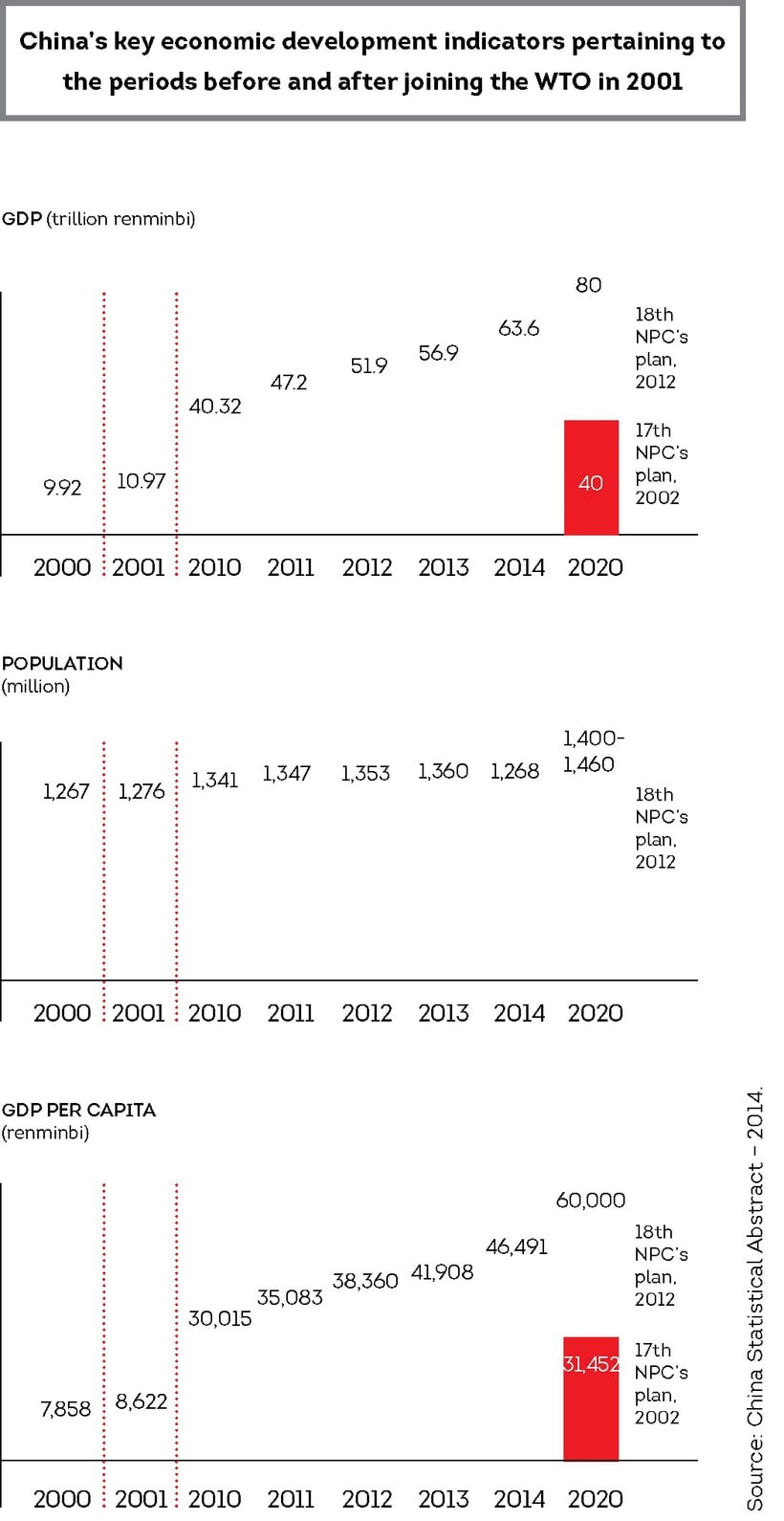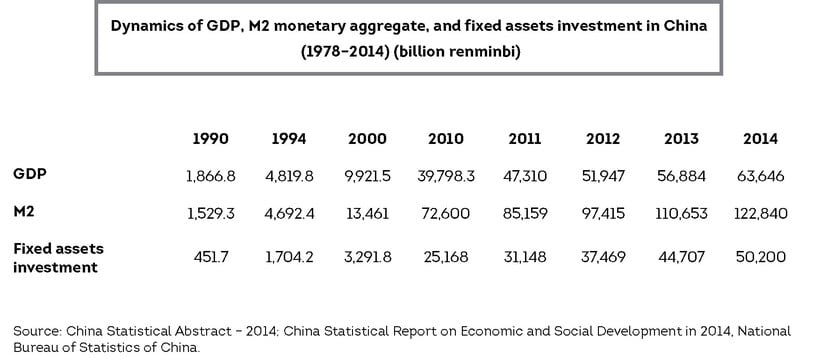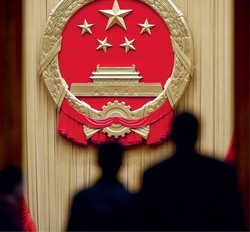Onward, to the Fuyu Society
China’s current economic slowdown will not lead to a ‘hard landing,’ at least not in the next decade. A serious crisis is possible later on, but only if the government is unable to find solutions to China’s most serious challenges: its changing demography, energy security, and environmental problems.
In early March, Beijing hosted the third session of the 12th National People’s Congress (NPC). It examined China’s social and economic development in 2014 and set goals for 2015, the final year of the 12th Five-Year Plan. The main report on the country’s economic and social development was made by Chinese Premier Li Keqiang, who openly acknowledged the obvious: China’s economy is slowing down.
Last year, Chinese GDP grew by only 7.4% (to 63.6 trillion renminbi, or $10.2 trillion), against an annual average of 10.2% over the last decade. It was the lowest figure since 1990. Still, the head of the government says there is no cause for concern – the country is entering a so-called ‘new normal’ phase, abandoning its previous policy of ‘GDP growth at all costs’ and charting a course that will improve the structure of its economy, even at the expense of certain economic slowdown.
“The Chinese economy has entered a state of new normal. The gear of growth is shifting from high speed to medium-to-high speed, if I could compare the Chinese economy to a running train. What I want you to know is that this train will not lose speed or momentum. It will only be powered by a stronger dynamo and run with greater steadiness, bringing along new opportunities and more momentum for growth,” said Li Keqiang. “What I want to emphasize is that China will not experience a regional or systemic financial crisis; the Chinese economy is not heading for a hard landing.”
The last remark, of course, was not accidental. It was intended to reassure market experts, who found reason to worry after the publication of the latest GDP figures. Rumor has it that China has fallen into the ‘middle income trap’ and the country will face an economic crisis in the near future.
At any rate, objective analysis does not favor the alarmist point of view. Broadly speaking, an economic ‘cooling off’ was projected in 2011 when China was preparing the upcoming five-year plan. The focus was not on perfunctory indicators, but on achieving new qualitative benchmarks of social development, the environment, and scientific and technological progress. Last year has shown that China will not just reach its intended targets, but will also exceed them.
The IMF estimates that in 2014 China overtook the United States as the country with the world’s largest GDP, when measured using purchasing power parity. China also surpassed America as the largest trading power in the world, increasing the volume of its international trade by 2.3% to 26.4 trillion renminbi ($4.3 trillion). On the other hand, the share of international trade relative to GDP (41.5%) and the export quota returned to 2003 levels, which indicates a significant limitation of the country’s capacity to stimulate growth by increasing supply to foreign markets.
In turn, the inflation rate was only 2%, with a simultaneous decrease in producer prices by 1.9%. This occured despite 12.2% growth in M2 money supply (all liabilities, securities, stocks, bonds, etc.) to 122.8 trillion renminbi ($19.8 trillion), or 200% of GDP, one of the highest rates in the world. Such a low rate of inflation, even in the face of high monetization of the Chinese economy, which experts often cited as a risk factor, can be explained by the continuous growth of investment in production assets – by 15.7% to 50.2 trillion renminbi ($8.1 trillion) in the past year – and an increase in production aimed not only at the domestic but also foreign markets.
In the area of fiscal policy, China has kept the expenditure side of the budget low relative to GDP at 24.2%, albeit with a small increase of the budget deficit to 1.62 trillion renminbi ($260.8 million). At the same time, retail sales have grown 12% to 26.2 trillion renminbi ($4.2 trillion), with two-thirds coming from residents of urban areas. For the first time since the mid-1980s, average per capita income of the rural population has begun to outpace the income of urban residents.
A risk for tomorrow
These figures unmistakably demonstrate that recession, least of all economic collapse, is nowhere on the horizon for China. However, no one is trying to deny the existence of certain problems in the local economy. To some extent, the most important ones are reflected in the program for the current year, which was discussed at the All-China working conference on economic issues in Beijing last December, as well as at the March session of the National People’s Congress. These meetings also defined the direction of the main economic policy and China’s six major goals:
- Ensuring food security;
- Curbing the debt burden growth in regional budgets;
- Improving living standards;
- Balancing national economy and industry;
- Coordinating regional development; and
- Increasing the level of openness in the economy.
However, China’s biggest problems are not the day-to-day ones, which are addressed annually during scheduled party and government meetings. The most serious and long-term fundamental threats are China’s vast population – which includes fewer and fewer working-age residents – a lack of energy resources, and pollution. The exacerbation of these problems could plunge the country into a serious economic, and subsequently political, crisis.
In the area of fiscal policy, China has kept the expenditure side of the budget low relative to GDP at 24.2%, albeit with a small increase of the budget deficit to 1.62 trillion renminbi ($260.8 million). At the same time, retail sales have grown 12% to 26.2 trillion renminbi ($4.2 trillion), with two-thirds coming from residents of urban areas. For the first time since the mid-1980s, average per capita income of the rural population has begun to outpace the income of urban residents
The authorities are aware of the risks and have already taken preventative steps. For example, in late 2013, in order to address the growing labor shortage, China altered its one-child policy, which was launched in 1979. Specifically, a couple can get permission to have a second child if at least one spouse is an only child. Authorities also need to refocus their policy from one of attracting unskilled labor from rural areas to increasing labor productivity, and shift from extensive to intensive forms of production development and an innovative economy. This is the key to addressing China’s main challenges of a shrinking economically active population, its aging demographic, and a relative lack of natural resources and environmental protection through the use of energy-saving technologies.
It is no secret that environmental problems in China have been serious in recent years, especially in the north and northeast of the country where large industrial factories were built by Japan in the 1930s. In fact, air pollution, large volumes of industrial waste in water and soil, and excessive use of natural resources is how China is paying for its industrial leap in years past. Thus, if the Chinese government is not prepared to change its demographic policy, stimulate technological innovation, and transform the structure of its economy, the country will face serious economic and environmental challenges – given the shortage of cheap labor and a lack of energy resources.
In this case, the former Celestial Empire may indeed find itself in the ‘middle income trap,’ which has already caught many developing countries that previously experienced growing prosperity and a rapidly growing economy. An increase in wages and the extension of employee insurance to migrants with a registered address in a rural area (the most important reserve to stimulate domestic consumption) could mean that China may lose its advantages in international competitiveness because of rising production costs. The inevitable consequences would follow – a decline in exports, a surge in unemployment, and an unpredictable destabilization of the economy and the political arena.
Be that as it may, these risks will not materialize tomorrow. Strong macroeconomic indicators such as continuing high rates of growth (as compared to the global level), a stable financial system, moderate public debt, substantial corporate and private funds that serve as a banking ‘safety cushion,’ and the Chinese authorities’ knack for solving problems quickly and effectively all point to one unequivocal conclusion: a ‘hard landing’ is not in the cards for China in the next five to ten years. Moreover, current plans envision the country reaching the level of a Xiaokang (a moderately prosperous society) by 2020, and a Fuyu (a common prosperity society) by 2030. These goals, however, will only be achieved if the Chinese government is able to find a solution to those fundamental challenges already forming in China’s path.
The All-China Agenda for the Year
Ensuring food security
Although China has been rapidly increasing food production over the past 10 years, problems remain – increasing levels of urbanization, less arable land, and exacerbation of environmental problems. To address these problems, it is vital that the country strike a balance between food production and consumption.
Limiting debt risk in the regions
In recent years, regional Chinese authorities got carried away with issuing municipal securities to finance construction of major facilities without adequate collateral. The consequence of such policies has been a rapid increase in ‘bad debt’ for regional budgets, which may lead to greater difficulties if the debt burden increases further. As a precautionary measure, China has already decided to limit unsecured loans for capital construction.
Raising the standard of living of the Chinese population
It was decided that China would have to pursue a more active policy of employment this year (especially with regard to university graduates and ‘excess’ population, including migrant workers from rural areas), develop the country’s social security system, and speed up construction of affordable social housing. Measures are also planned to boost employment and create at least 10 million new jobs in urban areas, maintaining an urban unemployment rate of 4-5%.
Raising the retirement age
This idea is particularly relevant given the shrinking working-age population as a result of the one-child policy that was instituted in the late 1970s. Today, China still follows the Regulation on Employment Insurance from 1953, which sets the retirement age for men and women at 60 and 55 respectively, and 50 for certain professions. The country is expected to develop and adopt a new law on employment insurance in 2017, which will increase the retirement age by five years.
Solving the ‘three times one hundred million’ problem
This task includes three components: 1) registering the 100 million migrant workers from rural areas in towns and cities; 2) renovating and building new housing for 100 million people living in dilapidated urban neighborhoods and rural areas within city limits; and 3) the launching of urbanization in less developed central and western regions of the country with a population of 100 million people.
Environmental protection and energy efficiency
Until relatively recently, China’s environmental problems in connection with economic growth were simply ignored. However, the rapid development of manufacturing in the last three decades has led to serious pollution, forcing authorities to change their policy in this area. In 2015, two indicators will receive special attention: the share of renewable energy (solar, water, wind, bio-resources, and others) in the total figure of primary energy consumption, which is expected to increase from 8.3% to 11.4% in 2010, and reducing the energy intensity of GDP from 20% in 2006-2010 to 16% in 2011-2015.
Education, science, and technological innovation
This area is an important part of rising to the new challenges
associated with a shrinking share of an economically active population, a
shortage of energy resources, and pollution. The country is planning a
substantial increase in R&D expenditure as a share of GDP – from
1.76% in 2010 to 2.2% in 2015. Another goal is to increase the number of
patents and inventions from 1.7 to 3.3 per 10,000 people. These goals
seem especially ambitious considering that the country was unable to
achieve similar targets in previous years.














